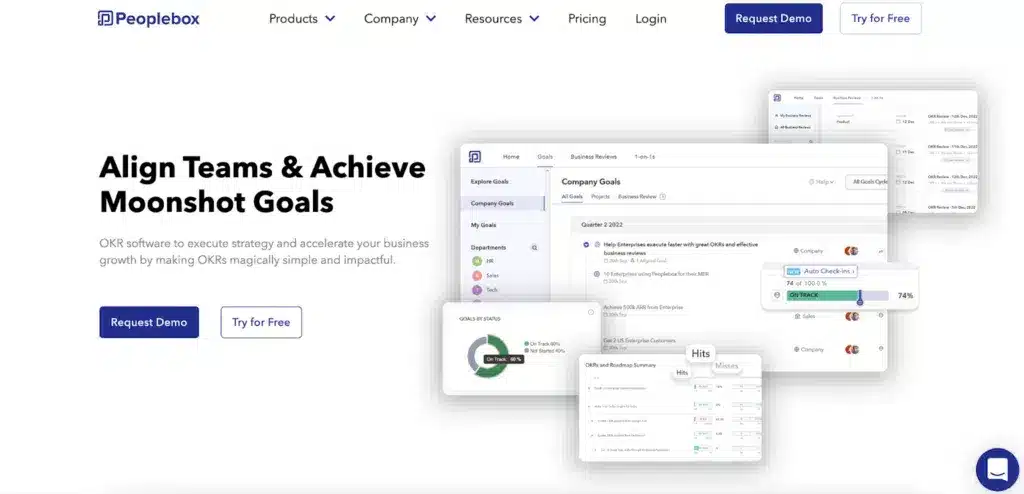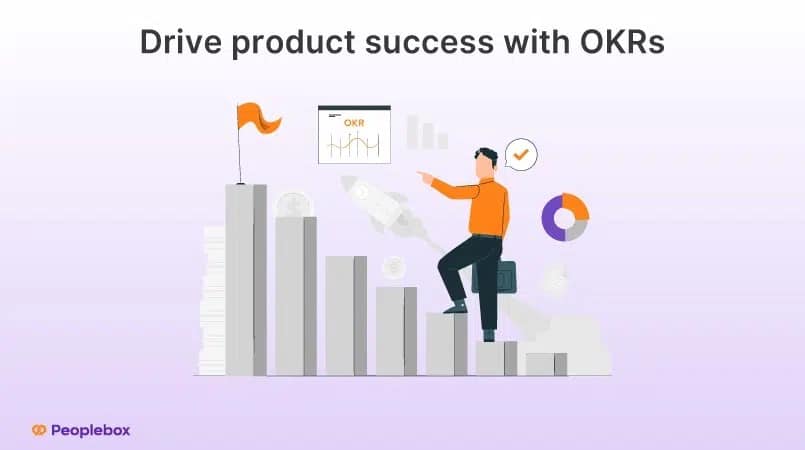As a product manager, you have a clear vision – build a product that excels in quality and beats the competition in the market.
But to reach that goal you need to:
- Set the right objectives for the team,
- Track how close they are to completion, and
- Ensure that each task is carried out with quality in mind
Using product OKRs (Objectives and Key Results), you can ensure that all these aspects of product management are taken into account and you reach the set goal – the best product in the market.
If you’ve not used OKRs for your product management team before, don’t worry. Post reading this article, you understand how you can leverage OKRs for your product management team along with:
- What are Product Management OKRs, and Why do you Need Them?
- Are Product OKRs and Product Roadmaps the Same?
- How to Set Up the Best OKRs for your Product Team?
- How Peoplebox Helps You Track & Review Product Management OKRs
Without any delays, let’s dive in.
What are OKR Product Management, and Why do you Need Them?
OKRs in product management are used to set clear and inspiring goals for product development. They help you track progress through specific, actionable key results. It’s important to note that OKRs in product management should be distinct from the product strategy, which outlines the overall direction of the product in terms of value delivery.
Product OKRs help to bridge the gap between its strategy and the final product that customers receive. For this reason, it is common for product managers and other team members to use OKRs throughout the product development cycle and at various levels of the hierarchy.
For example, OKRs can be used to support the product strategy, its roadmap, and even escalate its delivery time.
By using OKRs, product managers can ensure that their work is aligned with the organization’s overall goals and that the product is delivered to customers with quality.
But why are OKRs important for product managers
From launching a product to maintaining and upgrading its performance, product managers have a lot of tasks to perform. They need an approach that helps them stay on track and achieve the desired results. This is probably why the product OKRs come into the picture for managers. But there are other reasons why they need them. Here’s a quick list to help you get acquainted with them:
Identifies important tasks
Without proper prioritization, teams can easily get sidetracked and move to the next task without fully completing the current one. OKRs help solve this problem by focusing on the most important priorities rather than simply moving to the next step in the workflow. By setting clear OKRs, teams and organizations can establish a clear direction and stay focused on crucial tasks. This ensures that resources are used efficiently, and a steady progress is being made to achieve the organization’s goals.
Improves agility
Agile product management is a popular approach for many organizations because it allows them to adapt to changing circumstances. One of the benefits of using OKRs in an Agile setting is that they do not require a complete overhaul of the strategy to be effective. Instead, OKRs become flexible as they can be modified at any point in the process. This makes them a useful tool for organizations that rely on Agile methodologies, as they can be incorporated into the existing workflow and adjusted as needed.
Increases transparency and accountability in product teams
Organizations can create a more engaged and motivated workforce by collaborating with individual team members to set and achieve their OKRs. When team members outline their objectives and key results, and work towards achieving them, they are likely to take ownership of their work and feel a sense of accomplishment and satisfaction. This can lead to higher happiness and engagement, ultimately contributing to the organization’s overall success.
Now you know why using OKRs is essential for product management teams. But are product OKRs and product roadmaps the same? Let’s discuss it!
OKR Software - Rated 4.8 on G2
Empower your managers to be a better leader with essential performance tools & personalized coaching support.
Are Product OKRs and Product Roadmaps the Same?
Product OKRs and product roadmaps are distinct, although related, concepts. A product roadmap outlines the steps and resources needed to design, develop, and release a product according to a defined timeline and budget. It generally focuses on the product development process’s output rather than the work’s outcomes.
On the other hand, product OKRs focus on the work’s outcomes rather than the output. For example, we can say that while a product roadmap might outline a specific product update, product OKRs would outline the impact of that update on teams or company goals.
Product managers must consider roadmaps and OKRs in their work, as they each provide valuable insight and guidance for different aspects of the product development process.
How to Set Up the Best OKRs for your Product Team?
To avoid spreading your team thin, set up OKRs that consider people’s productivity levels, recognize their focus topics, and inspire creativity. Here’re a few ways to help you set OKRs for your product team.
Develop an overview of product performance through key results

Developing an overview of product performance through key results is crucial for setting OKRs. That’s because it allows you to identify the most important areas for focus and set specific, measurable goals for improving your product. It also helps you track progress for these goals and make informed decisions on how to achieve them.
With a clear understanding of your product’s performance, it can be easier to set meaningful OKRs to drive real progress and improvement. By regularly tracking key metrics and analyzing the data, you can gain insights into what is and is not working for your product. Use this information to set targeted OKRs to help you move the needle on your most important objectives.
In addition, setting OKRs based on key results can help you align your team’s efforts with the overall goals and priorities of the company. This approach will help you ensure that everyone is working towards the same objectives. On top of that, this can lead to greater collaboration and more effective use of resources, ultimately resulting in improved product performance.
Create OKRs and prepare an action plan with your product team
To start working towards your OKRs, brainstorm the key results with your team. Collaborate to ensure everyone is aligned and working towards the same goals. Once you have identified your key results, it’s time to take action to achieve them. Remember to regularly review and adjust your OKRs to remain relevant and achievable.
Differentiate between outcome and output OKRs

Outcome OKRs refer to the desired change in behavior or impact that you want to achieve. They focus on the end result rather than the specific actions or tasks required to get there. Output OKRs, on the other hand, are the specific actions taken to reach the desired outcome.
It is possible to set either outcome or output OKRs; the most appropriate type will depend on your team’s specific goals and objectives. In a few cases, it may be more effective to set output OKRs to get started and build momentum toward achieving the ultimate outcome. It is important for product teams to know the difference between outcome and output OKRs and carefully consider the type most appropriate for their goals and objectives.
Keep reviewing the OKRs
To continually improve your OKR process, it is important to schedule a comprehensive review and reflection meeting. Also, try reviewing documents and encourage team members to reflect on the entire OKR exercise.
This can provide valuable insights that help you revise the process and make it more effective in the future rounds. By regularly reviewing and reflecting on the OKR process, you identify areas for improvement and adjust your approach to ensure you are get the most value from your OKRs.
How Peoplebox Helps You Track & Review Product Management OKRs
With a good idea around how one can set up the best OKRs, let’s check out how Peoplebox can help you set and manage your product management OKRs. Here’s a quick description on what Peoplebox is and what it does.
What is Peoplebox & how it works?

Source: Peoplebox
Peoplebox is one of the top OKR software solutions that helps more than 500 businesses track and align their business strategies efficiently. The single-page view helps their users get an idea how close they are to completing a task. As users, you can create annual tasks that can further be divided into tasks for individual departments. This gives managers a better understanding of how their team is performing and whether they are meeting their deadlines as discussed during the onset of the objectives. What’s more, managers can even track the progress of objectives for individual team members. This gives them a detailed insight on how each member is performing in the team.

Top features of Peoplebox
Here’re some of the best features of Peoplebox.ai that you must look out for:
Customizable OKR/business review dashboards
Get customizable dashboards that create presentable OKR and business review reports with PeopleBox. These dashboards are customizable and can include charts, key performance indicators (KPIs), and narrations that automatically populate the OKR progress and delta.
Integrate with other platforms to track goals
It can integrate with more than 50 tools that help your team collaborate and align tasks better. The list is inclusive but not limited to: Jira, Asana, Hubspot, Salesforce, Google Sheets, MS Teams, and more. This allows you to update OKRs and projects automatically without requiring changes to your team’s workflow or behavior.
Easy-to-use single page application
Track and align your objectives in a single-page view with PeopleBox. The OKR software enables its users to get performance highlights, view how different OKRs are aligned with the goals of the business, and demonstrates how each team is close to completing their objectives with the progress bar view.
Track goals in real-time
You can also track the progress of each objective in real-time. With a unified view, you not only track the progress of one but all the tasks that are created and assigned to all the team members. This makes it easier for you to understand how your product management team is performing and are close to completing their dedicated tasks.
Draft OKRs with coaches
Peoplebox also gives you the option to bring an OKR coach onboard. Their OKR coaches help all clients draft effective OKRs that are comprehensible for teams and can be followed in the long run.
What does OKR mean for businesses in 2024?
Time to Make Effective OKRs for Your Product Management Team
We’ve understood that OKRs for product management are inclusive of product strategy, delivery, vision, roadmaps, and discovery. A combination of these helps organizations align all their team’s efforts toward the overall strategy and goals. While designing the perfect OKRs may take time and require frequent iteration, having a clear strategy and strong teamwork can make the process more streamlined.
OKRs help employees work purposefully and drive the organization’s success by empowering team members to set challenging goals with measurable results.
It may sound challenging, but with the right tool you can achieve this goal and make sure that every team member is aligned with the organizational goals as well.
Brands like Peoplebox can help you get a headstart in this direction. As a leading OKR software, it helps you execute strategies and accelerate your business growth by creating OKRs using its AI.








